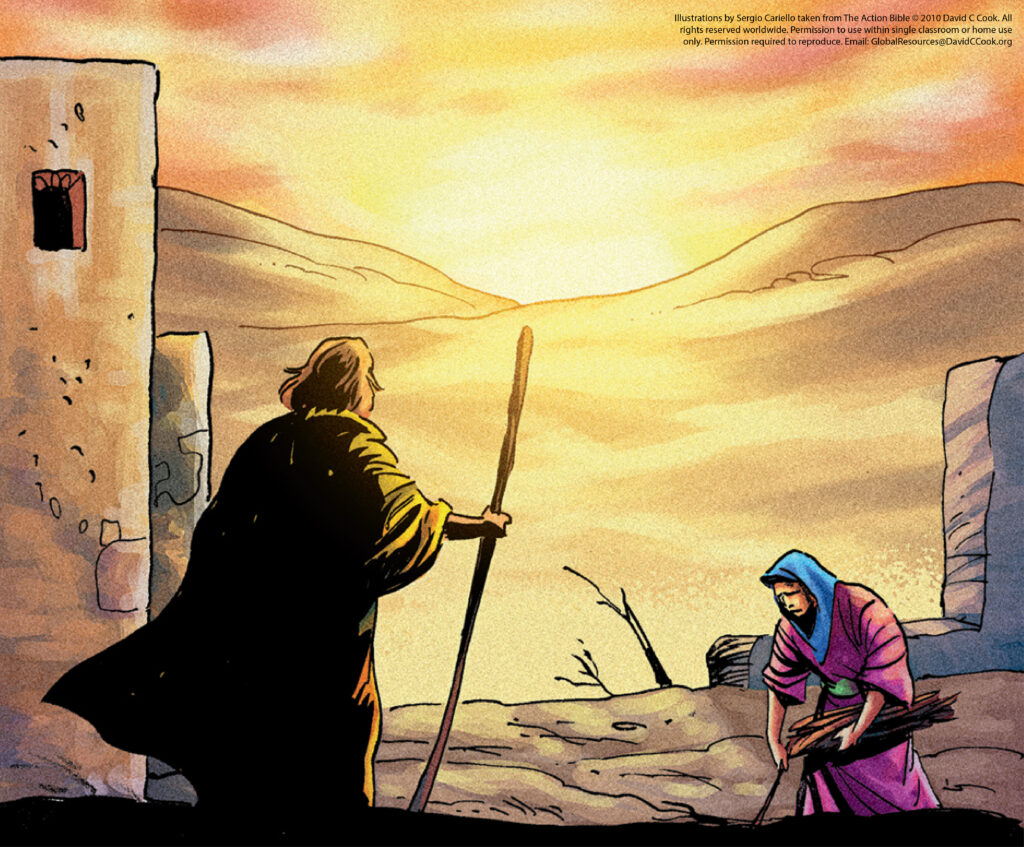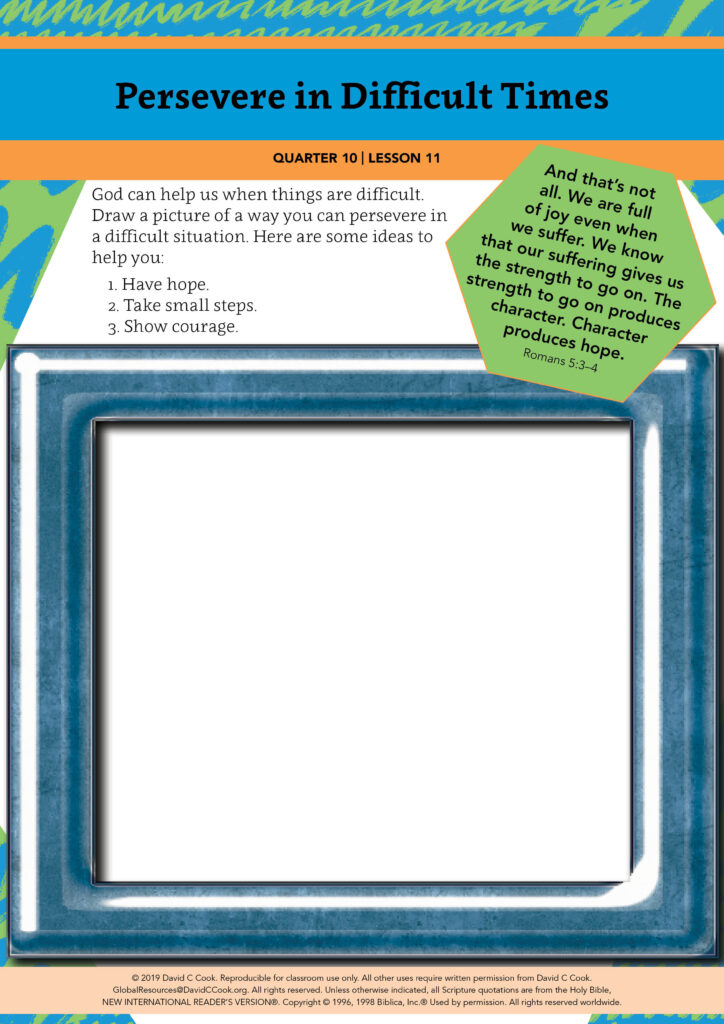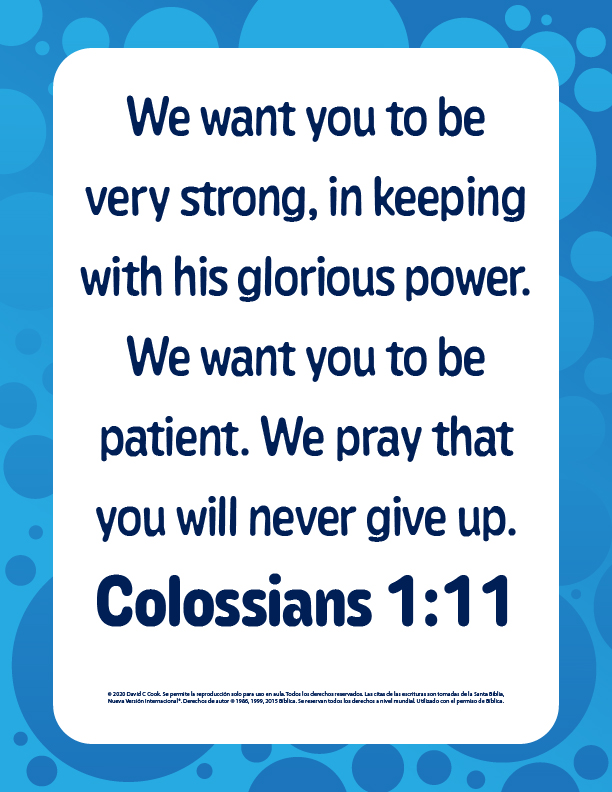During the lesson, the information for you to know is written in regular type, and what we suggest speaking or reading aloud to children is in bold. All resources for this lesson, including the Teacher Guide, Student Page, Family Connection Card, and other resources can be downloaded in a ZIP file by clicking on the following link:
In some lessons you will find "resource articles." These are articles written by experts from around the world to help equip you for your work with children and adolescents. Share them with parents or guardians if you consider it appropriate.
Before class, clear a large area in your teaching space. If possible, plan to do the Connecting activity outside.
You need to persevere so that when you have done the will of God, you will receive what he has promised.
Hebrews 10:36, NIV
When we experience challenges but continue to trust that God has good plans for us, we can often look back afterwards and see His amazing work in our lives. But when our difficulties seem so overwhelming that we cannot see what to do, we may lose sight of the One who knows the way we should go. We may become stuck in disappointment, anger, fear, and hopelessness and fail to reach out for God’s mighty and loving hand to lead us. In these situations, His way is clear: perseverance.
What difficult things has God called you to do? What challenges will require you to persevere? Write them down and think of small steps you can take to persevere in these situations. Ask for God’s strength and guidance. Then take on the challenges 1 step at a time. Give each disappointment and each source of anger or fear to God. When we continue to trust in God in difficult times, we can begin to find joy, even in our challenges.
Encourage the family members to share some difficult situations they have faced and how they practiced perseverance in those situations. This will help the children know they are not alone in facing challenges.
Teacher Tip: If possible, email or text the Family Connection Card to the families of your students.
Greet the children as they arrive. As they enter, have them sit at 1 end of the teaching space. Ask them how many steps they think it will take for them to get from 1 end of the cleared area to the other end.
Would it be easier to take big or small steps to reach the other end of the space?
Allow 1–2 children to respond.
It would be easier to take big steps because you could move faster and farther with big steps. However, you will race by taking the smallest steps you can. This will require perseverance because it will probably be difficult not to take faster steps. After all, this is a race!
Show the children how to take very small, quick steps toward the other side of the cleared area.
If you take big steps, I will ask you to start over. So be sure to take very small steps! When I say, “Go!” you may begin. Ready? Go!
As the children take small steps toward the other end of the cleared area, watch for those who are taking large steps and ask them to begin again and take small steps. As the children reach the other end of the space, congratulate them for their efforts. Then encourage them to clap for and congratulate the other children.
In our last class, we talked about perseverance. What is perseverance?
Allow 1–2 children to respond.
When you persevere, you try again or do not quit even when something is difficult. This race was probably more difficult than you thought it would be. It is easy to race when we are running fast or when we can take big steps. It is much more difficult when we take small steps, and it takes us a lot longer to get to the finish. That is perseverance!
Perseverance helps us to get through difficult things. It also helps us in other ways. It makes us feel better about ourselves and helps us to be more thankful. Perseverance also helps us to do what is right, even when it is difficult. Perseverance helps us to become more hopeful, even in difficult situations.
We all have difficult times in our lives when we may feel scared or sad or angry. And we may wonder if that situation will ever change. When we face a challenge and feel like we cannot possibly persevere through it, there are some things we can do.
Ask the children to stand.
I will tell you a story from the Bible. As you listen to the story, we will figure out how the woman in the story persevered through difficult situations.
Optional: If possible, share the image from The Action Bible.

The Bible tells a true story of a widow who persevered when her life was very difficult. A widow is a woman whose husband has died. The widow in our story had struggled through many challenges. She did not have a husband to provide for her family. She had very little hope left until a man called Elijah came to town.
Elijah was a prophet of God. This means that God told Elijah what He wanted His people to know and Elijah gave the messages to the people. One day, God told Elijah to go to the town of Zarephath. There, Elijah met the widow. Elijah asked her for some water and bread. But the widow explained she only had enough flour and oil to make a small loaf of bread for herself and her son. It was to be their last meal because then they would not have any more food.
How do you think the widow might have felt knowing that she did not have enough food to eat?
Allow 2–3 children to respond.
The widow did not sound very hopeful. Life was not easy for the widow and her son. The rains had stopped in Zarephath, so the rivers had dried up and many of the crops had died. Listen to what Elijah said to encourage her:
If possible, read these verses directly from your Bible.
Elijah said to her, “Don’t be afraid. Go home. Do what you have said. But first make a small loaf of bread for me. Make it out of what you have. Bring it to me. Then make some for yourself and your son. The Lord is the God of Israel. He says, ‘The jar of flour will not be used up. The jug will always have oil in it. You will have flour and oil until the day the Lord sends rain on the land.’”
1 Kings 17:13–14
What would flour and oil allow the widow to make?
They would allow her to make bread.
Why is this important?
This would give her and her son food to eat.
The widow chose to believe what Elijah told her. She decided she and her son would make it through their difficult situation. She showed strength and did not give up.
Which of the 3 ways we learned to have perseverance did the widow show? Did she have hope? Did she take small steps? Did she show courage?
She showed courage.
Lead the children in doing the motion for “show courage.” Squat down low with your hands touching the ground. Spring up and reach your hands up high above your head.
God did exactly what He said He would do. The widow did not run out of flour or oil until the rain came to help food grow again. The widow continued making bread for Elijah and her family.
Which of the 3 ways we learned to have perseverance did the widow show? Did she have hope? Did she take small steps? Did she have courage?
She took small steps.
Each day, the widow took small steps by making bread. She kept her family and Elijah fed so they could persevere through a time when there was not any other food.
Lead the children in doing the motion for “take small steps.” Lift your feet slightly and step in place 3 times.
This is not the end of the widow’s story. The Bible explains that the widow faced another challenge. Her son became very sick. Then he stopped breathing!
Allow 2–3 children to respond to each of the following questions.
How do you think the widow felt when her son stopped breathing?
What could the widow have done to practice perseverance in this situation?
It is okay if the children do not have an answer to this question.
The widow could have had hope. She also could have shown courage in getting through her situation. Let’s listen to what happened next.
The widow became angry that her son was sick. She asked Elijah why this bad thing happened, and she even blamed Elijah for her troubles. The widow was angry, but Elijah helped her persevere. He brought her son upstairs and asked God to give the boy’s life back.
Which of the 3 ways we learned to have perseverance did Elijah show? Did he have hope? Did he take small steps? Did he show courage?
Allow 2–3 children to respond.
Elijah had hope knowing God had sent him to the widow to do good.
Lead the children in doing the motion for “have hope.” Stretch your arms out in front of you with your palms up. Slowly raise your arms until they are lifted toward the sky.
Elijah’s hope in God helped the widow and the boy. Listen to what the Bible tells us happened next:
The Lord answered Elijah’s prayer. He gave the boy’s life back to him. So the boy lived. Elijah picked up the boy. He carried him down from the upstairs room into the house. He gave him to his mother. He said, “Look! Your son is alive!”
1 Kings 17:22–23
Elijah did not give up hope. He also helped the widow to have hope. In her suffering, the widow found hope to go on. She knew God would do what He promised. Listen to what the Bible says about perseverance and hope.
And that’s not all. We are full of joy even when we suffer. We know that our suffering gives us the strength to go on. The strength to go on produces character. Character produces hope.
Romans 5:3–4
When we persevere through difficult times, we develop the strength that comes from God. We can ask God for help in difficult situations. We may not experience miracles like the widow did. But God promises He will always be with us, and we can trust Him to do what is best for us. He has good plans for our lives, and He will help us to persevere!
Have the children sit in a line on 1 end of the cleared area.
Let’s do an activity to help us learn to persevere in difficult situations. Think about a difficult situation in your own life. How can you persevere in this situation? When you have thought of an idea, stand up.
Pause and allow the children to think and stand when they have thought of an idea. If they need help thinking of ideas, suggest some challenges you have faced or some you know they face. When all of the children are standing, continue with the lesson.
In a moment, we will complete part of a sentence using the difficult situation you just thought of. You may say this out loud when I pause.
When I must do something difficult such as (pause and encourage the children to say the difficult situation).
Now, let’s think of a way we can persevere in this difficult situation.
Which of the ideas we learned today might help you to practice perseverance in your difficult situation? Show me the motion that goes with this idea.
Pause to allow them to show their motions. Then have them stand in their line.
Let’s practice putting this into our sentence. When I pause, you will show your motion for how you can persevere.
Give an example of how to complete the sentence by showing your own perseverance motion when you read the sentence that follows. This will help the children understand what to do. Then invite the children to do the motion with you.
I will persevere by (pause and show your motion).
Encourage the children to do a motion to show how they will persevere.
Let’s all practice what we will do when we are faced with a difficult situation. I will start a sentence. When I pause, you will finish it either out loud or quietly in your mind. Then you will show the motion for how you will persevere. Ready?
When I must do something difficult such as (pause), I will persevere by (pause).
Optional: If you are using the Student Pages, give the children crayons. Allow 2–3 minutes for them to do the activity on their pages.

Our memory verse reminds us we can trust God to help us persevere through difficult situations.
If you are using the Memory Verse Poster, show it to the students.
We want you to be very strong, in keeping with his glorious power. We want you to be patient. We pray that you will never give up.
Colossians 1:11

Repeat the verse and motion with the children 3 times. End class by saying a blessing, based on Hebrews 10:36, over the children.
Blessing: May you persevere to do the will of God. May you know that when you practice perseverance in doing the things He has asked you to do, you will receive the blessings He has promised.
Lead the children in singing this quarter’s song, if possible.
Life on Life ©2020 David C Cook. Reproducible for home or classroom use only. All other uses require written permission from David C Cook [email protected]. All rights reserved.